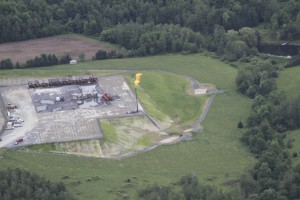Background document and resource materials provided by the Southern Environmental Law Center:
For the last two years, DMME has been considering improvements to Virginia’s oil and gas regulations— the process was initiated by an industry petition in December 2013 to use FracFocus in Virginia as a method to disclose fracking fluids used in well stimulation. DMME convened a Regulatory Advisory Panel including industry, agency staff, local government officials from the Taylorsville Shale Basin area and a member of the conservation community (Nikki Rovner from The Nature Conservancy). The draft regulations are out for public comment until December 4. You can read all the details on the Virginia Regulatory Town Hall Town Hall Public Comment: (Sample Action Letter for your use )
The Draft Regulations Do the Following:
- Require fracking fluid disclosure to DMME; publicly available through industry-managed FracFocus
- Require groundwater baseline sampling, analysis and monitoring plan; 1⁄4 mile radius
- Require spill contingency plan
- Adopt technical standards for well integrity—including the use of centralizers for well casings,the completion of a cement bond log, and pressure testing requirements
- Require waste pits to be enclosed by adequate fencing to secure the site
- Acknowledge local government’s land use authority and require applicant to certify they arefollowing all local land use ordinances
- Require pre-application meeting in Tidewater between industry, agencies and locality
- Improved coordination between DMME and DEQ
While these improvements are a step in the right direction, significant gaps continue to exist in Virginia’s regulatory framework. These gaps must be closed.
Three significant improvements DMME can make to further improve oil and gas regulations are:
- 1) DMME should maintain a distinct and separate disclosure registry.
Disclosure of fluids used in oil and gas production and the public’s access to this information is essential. The Department of Mines, Minerals and Energy should not rely solely on an external industry-sponsored website for public disclosure. DMME should maintain its own chemical registry that provides thorough and clear information to the public. In a previous version of the draft regulations, staff included the following in Part B of 4VAC25-150-365: “The Department shall obtain and maintain data submitted to the Chemical Disclosure Registry.” Discussion during the Regulatory Advisory Panel meetings included this important component of the regulations and many members of the Panel and the public were supportive of its inclusion. This language should be returned to the draft regulations. - 2) Reduce water consumption.
Large water withdrawals for high-volume hydraulic fracturing can deplete water supplies for drinking, irrigation and other uses. On average, a single Marcellus shale frack job in Pennsylvania requires 4.2 million gallons of water1. Stress on Virginia’s Potomac Aquifer is well known and oil and gas operations regulated by DMME should not increase the stress on this vital resource. Recycling and reusing wastewater can reduce the drain on local aquifers, reduce truck traffic, and reduce the amount of wastewater requiring disposal at the end of a drilling operation. In response to the large volumes of water used by Marcellus wells, Pennsylvania now requires that operators have an approved water management plan which includes conditions on water withdrawals to protect other uses and reuse plan for wastewater2.DMME should require disclosure of proposed water sources and quantities for drilling in permit applications; standards and procedures for mandatory recycling and reuse of wastewater should be created; and DEQ approval should be required for all ground and surface water withdrawals associated with drilling operations. - 3) Eliminate the use of wastewater pits.
Wastewater pit failures and overflows are a significant source of groundwater and surface water contamination risk for drilling operations. 25% of all environmental violations documented at Marcellus Shale wells in Pennsylvania during 2010 stemmed from pit and storage problems3. In 2012, the state’s Department of Environmental Protection recommended eliminating the storage of produced fluids in pits: “The long-term storage of production fluids in a pit presents an unacceptable risk to the environment through leaks or overtopping of the pit.”4DMME should eliminate the routine use of wastewater pits in Virginia for flowback and produced wastewater and require that all wastewater be managed in a closed loop system. Wastewater storage, if any, should be in watertight tanks placed inside secondary containment structures
Logistics:
The full text of DMME’s proposed rules Town Hall View Stage.
The agency is taking comments until December 4. Comments can be submitted to Mike Skiffington: mike.skiffington@dmme.virginia.gov, by fax (804-692-3237) or through the Town Hall website.
Two remaining public hearings will occur November 2, 2015
2:00 pm
University of Mary Washington, Dahlgren Campus 4224 University Drive, King George, VA 22485
November 3, 2015
2:00 pm
Virginia State Capitol, House Room 3 1000 Bank Street, Richmond, VA 23219
Additional information:
Other states have elected to prohibit fracking altogether. For example, after seven years of study and environmental review, the New York Department of Environmental Conservation decided in June 2015 to prohibit fracking, concluding that there is “no feasible or prudent alternatives that would adequately avoid or minimize adverse environmental impacts and that address the scientific uncertainties and risks to public health” from fracking.5
Similarly, after more than three years of study to develop recommended best practices, Maryland’s Departments of the Environment and of Natural Resources concluded “[t]here is no doubt that unconventional gas development . . . has the potential to harm public health, the environment and natural resources.”6 The General Assembly then prohibited the use of fracking until October 2017 and required the Department of the Environment to adopt fracking regulations by October 2016. 7
1 See N.Y. Dep’t of Envt’l Conservation, supra n. 2, at 6-10.
2 58 Pa. Con. Stat. Ann. § 3211(m).
3 Natural Res. Def. Council, In Fracking’s Wake: New Rules are Needed to Protect Our Health and Environmnet from Contaminated Wastewater, 57 (May 2012), available at http://www.nrdc.org/energy/files/Fracking-Wastewater-FullReport.pdf.
4 Pa. Dep’t of Envt’l Prot., Office of Oil & Gas Mgmt., Summary of Proposed Conceptual Changes to Title 25 Pa. Code Chapter 78, 6 (Aug. 7, 2012).
5 NY Findings at 42.
6 Md. Findings at 2; see also Md. Dep’t of the Env’t & Md. Dep’t of Natural Res., Assessment of Risks from Unconventional Gas Well Development in the Marcellus Shale of Western Maryland 18 (2015), available at http://www.mde.state.md.us/programs/Land/mining/marcellus/Documents/A_Final_Draft_Cover_Ex_Sum_and_RA.pdf. 7 See General Assembly of Maryland, HB0449 (CH0481), available at http://mgaleg.maryland.gov/webmga/frmMain.aspx?pid=billpage&stab=02&id=hb0449&tab=subject3&ys=2015rs


